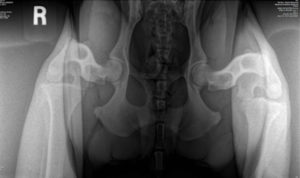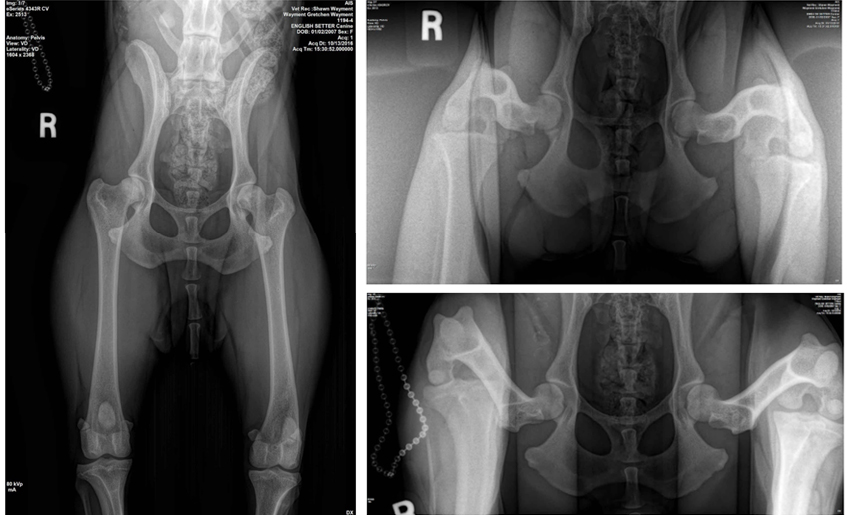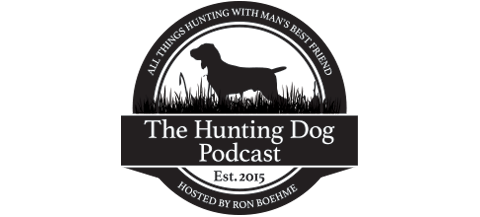Canine Hip Dysplasia and PennHip

By Shawn Wayment, DVM | Upland Ways
Robert G. Wehle wrote something in his excellent book Snakefoot: The Making of a Champion that has really struck me. His idea is that if you breed a dog for athletic function and not for structure (conformation), you are less likely to see orthopedic developmental diseases such as Canine Hip Dysplasia and others. I’m paraphrasing Bob, and this is not exactly how he wrote it…but he was correct. Bottomline: If you breed dogs with tight functional joints, their offspring will have tight functional joints.
Canine hip dysplasia (CHD) is a very common heritable or genetic orthopedic developmental disease where the hip joint has laxity (looseness) and the hip socket is shallow. Dogs with CHD wear out their joints over time because of their poor hip conformation leading to osteoarthritis, and ultimately causing the dog pain, discomfort and limited performance. CHD can be influenced by a multitude of potential causes including pelvic limb muscle mass, hormones, weight gain and growth, nutrition, and environmental factors but genetics are the most important factor. Currently, there is no effective cure for CHD and medical/surgical correction is mostly palliative at best. The earlier the diagnosis, the better the outcome will be for the medical management and surgical correction of CHD.
Traditional screening tests for CHD have consisted of a single hip radiographs (X-rays) of the pelvis with the dog on its back and the pelvic limbs extended at the age of 24 months. By 24 months, if a dog has CHD the joint damage is already done, surgical intervention at this age is limited to a total hip replacement and medical management is of limited value to alleviate pain. However, there is a newer screening protocol called PennHip.
PennHip is the acronym for Pennsylvania Hip Improvement Program and it was developed at the University of Pennsylvania in the early 1980’s by Dr. Gail Smith. PennHip is the most accurate hip screening tool available to us as dog owners and breeders today. The PennHip procedure involves sedation and three radiographic views of the hips. The three hip views consist of the traditional hip-extended view (similar to OFA), a compression hip view and finally a distraction of the hip view that is aided with a custom made distraction device.
The hip-extended view is identical to OFA’s certification radiograph. The dog is placed on its back and the legs are extended. This view is very good at diagnosing arthritis in the joint but is an inferior view for assessing laxity (looseness) in the hip joint. This view can not distinguish between dogs susceptible to CHD and those that are not.
The hip-compression view is taken with the dog on its back with the legs positioned in a neutral, weight bearing orientation and the head of the femur is gently rotated inward to seat it into the hip socket. This view is used by the radiologist to view important anatomical landmarks.
The hip-distraction view is the most important of the 3 radiographs. The dog is positioned in a similar manner to the compression view, however, a distraction device is used to aid in distracting the head of the femur out of the hip socket. This distraction is measured and reported as a degree of laxity (looseness) of the hip joint. The radiologist can make measurements on the distraction view and calculate what is call a distraction index or DI.
The distraction index or DI is the inherent distance the ball or head of the femur can be displaced from the hip socket or joint. The DI is calculated between the numbers of 0 (tighter hips) and 1 (Looser hips). The higher the number, the more laxity (looseness) in the joint. Each pet’s DI values are placed in PennHip’s database for future reference. PennHip will give the dog owner a print out of their DI and also show them on a graph where their dog fits compared to the other dogs in the database of the same breed.
How can the DI be used? Great question! Dogs with lower DI numbers have tighter hips and are therefore less likely to develop CHD. We as pet owners and breeders can (and should) breed dogs with tighter hips. Pets with a higher DI can begin lifestyle changes (diet, activity level, meds, etc) and therapies to help prevent osteoarthritis in the future. PennHip radiographs can be performed on a dog as early as 16 weeks of age which is a great advantage to the pet and owner. Dogs at 16 weeks of age can be removed from a breeding program if they have a higher DI and surgical/medical intervention can be initiated at 4 months of age.
(**The following photographs below are of my English setter Gretchen who is 10 yrs old and has been hunted hard. The views are hip-extended, hip-compression and finally hip-distraction. Gretchen has a very low DI and no evidence of osteoarthritis**)



THANK YOU for this wonderful piece. Perhaps it will help many out there understand the painstaking care some of us take when selecting and breeding animals. The testing comes early on – and a decision to breed or not breed is made using as much information as possible. PennHip is a valuable tool.
My understanding is that PennHip has a 16 week minimum age for an evaluation. My question is whether there is any evidence or studies showing that CHD phenotypes can increase and/or develop (or become more noticeable) more with the age of the dog? For instance, a 4 month old dog that can be evaluated under PennHipp guidelines is not yet physically or structurally finished growing. So is it possible that the structure of a 4 month old dog is different than the same dog at say 2 years of age, so that CHD might “develop” later or become more noticeable at a later age once the dog is fully grown?